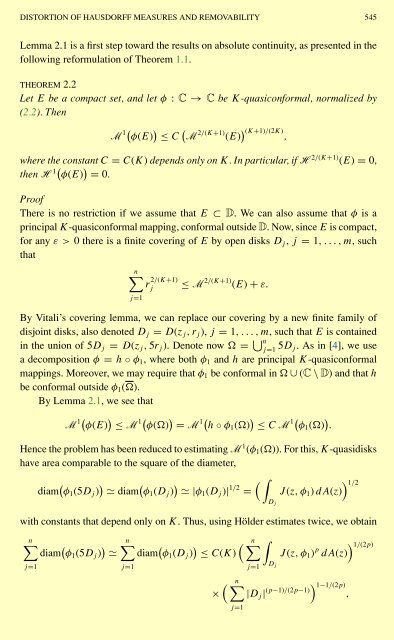A NULLSTELLENSATZ FOR AMOEBAS
A NULLSTELLENSATZ FOR AMOEBAS
A NULLSTELLENSATZ FOR AMOEBAS
Create successful ePaper yourself
Turn your PDF publications into a flip-book with our unique Google optimized e-Paper software.
DISTORTION OF HAUSDORFF MEASURES AND REMOVABILITY 545<br />
Lemma 2.1 is a first step toward the results on absolute continuity, as presented in the<br />
following reformulation of Theorem 1.1.<br />
THEOREM 2.2<br />
Let E be a compact set, and let φ : C → C be K-quasiconformal, normalized by<br />
(2.2). Then<br />
M 1( φ(E) ) ≤ C ( M 2/(K+1) (E) ) (K+1)/(2K)<br />
,<br />
where the constant C = C(K) depends only on K. In particular, if H 2/(K+1) (E) = 0,<br />
then H 1( φ(E) ) = 0.<br />
Proof<br />
There is no restriction if we assume that E ⊂ D. We can also assume that φ is a<br />
principal K-quasiconformal mapping, conformal outside D.Now,sinceE is compact,<br />
for any ε>0 there is a finite covering of E by open disks D j , j = 1,...,m, such<br />
that<br />
n∑<br />
j=1<br />
r 2/(K+1)<br />
j ≤ M 2/(K+1) (E) + ε.<br />
By Vitali’s covering lemma, we can replace our covering by a new finite family of<br />
disjoint disks, also denoted D j = D(z j ,r j ), j = 1,...,m, such that E is contained<br />
in the union of 5D j = D(z j , 5r j ). Denote now = ⋃ n<br />
j=1 5D j.Asin[4], we use<br />
a decomposition φ = h ◦ φ 1 , where both φ 1 and h are principal K-quasiconformal<br />
mappings. Moreover, we may require that φ 1 be conformal in ∪ (C \ D) and that h<br />
be conformal outside φ 1 ().<br />
By Lemma 2.1, we see that<br />
M 1( φ(E) ) ≤ M 1( φ() ) = M 1( h ◦ φ 1 () ) ≤ C M 1( φ 1 () ) .<br />
Hence the problem has been reduced to estimating M 1 (φ 1 ()). For this, K-quasidisks<br />
have area comparable to the square of the diameter,<br />
diam ( φ 1 (5D j ) ) ≃ diam ( φ 1 (D j ) ) ( ∫ 1/2<br />
≃|φ 1 (D j )| 1/2 = J (z, φ 1 ) dA(z))<br />
D j<br />
with constants that depend only on K. Thus, using Hölder estimates twice, we obtain<br />
n∑<br />
diam ( φ 1 (5D j ) ) n∑<br />
≃ diam ( φ 1 (D j ) ) ( n∑<br />
∫<br />
≤ C(K) J (z, φ 1 ) p dA(z)<br />
D j<br />
j=1<br />
j=1<br />
j=1<br />
( n∑<br />
) 1−1/(2p),<br />
× |D j | (p−1)/(2p−1)<br />
j=1<br />
) 1/(2p)
















